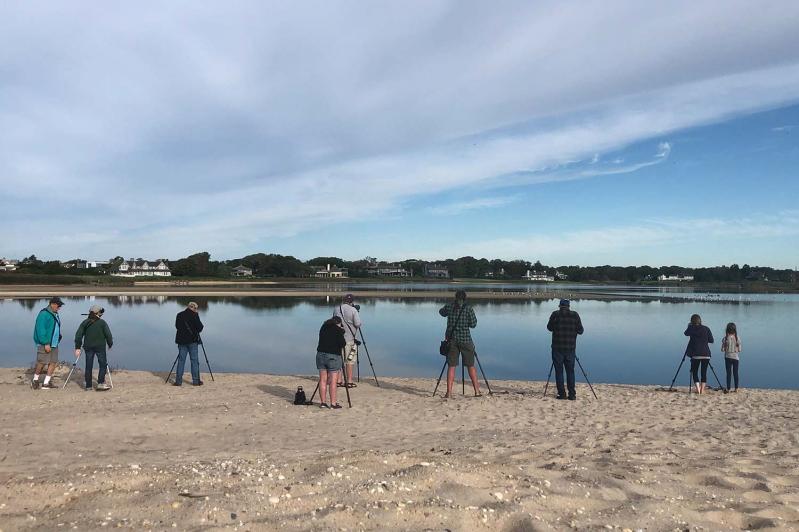When the ball drops marking the beginning of the new year, for some, a silent gun goes off and an invisible race begins. They’re the bird listers, and their goal is to find as many different species of birds as they can over the next year.
There are many variations of the game: Some restrict their lists to birds seen only at their houses, others keep “patch” lists, the patch usually a local area they check often. Some maintain lists of birds seen in the boundary of a ZIP code, while others build state, country, or even world lists. Lists can be further broken into time periods; months and years are the most popular, but some maintain day lists.
There are bird listers who live on the East End, but there are more bird listers who visit when a rare bird intersects the East End. Take, for example, a tufted duck that was spotted by Shai Mitra and his wife, Patricia Lindsay, in December. Hundreds of birders visited when it made Fort Pond its temporary home for a few weeks.
Here’s a quick, incomplete history of bird listing: Perhaps the first relatively popular book tangentially about listing was “Wild America,” written by Roger Tory Peterson and James Fisher in 1955. They traveled across North America and kept a tally of the birds they saw, but that wasn’t the sole focus of the book. In a footnote, Mr. Peterson mentioned he had come across 572 species of birds during their journey, and a subculture was born. By 1973, Kenn Kaufman was hitchhiking cross-country and covered 80,000 miles finding 671 species, which he chronicled in his book “Kingbird Highway.” In 2012, the movie “The Big Year”, starring Owen Wilson and Jack Black, was released, further popularizing the quasi-sport. Last year, 50 years after Kaufman’s trek, according to eBird, David and Tammy McQuade found 811 species in the United States.
The website and app eBird, where birders upload their sightings, has made listing easy. It is maintained by the Cornell Lab of Ornithology, which uses the data in part to understand bird movements and populations. Old-school birders dedicated piles of notebooks to the craft. When they died, the records were left to confused relatives, often troubled by tossing all that data.
In January, a group of Suffolk County birders have challenged themselves to see at least 100 birds this month alone.
“I guess the purpose is to basically not become a couch potato during a cold, dark month,” Eileen Schwinn, vice president of the Eastern Long Island Audubon Society, wrote in an email. “Having a goal and reason to get outside nearly every day is not such a bad thing, and we live in a fabulous area for winter birds.” Ms. Schwinn had seen 78 species as of yesterday. “It’s purely a competition with myself,” she wrote. Her highest total for January was 115 species.
Jay Rand, a high school math teacher who lives in Southold, and whose photographs often grace this column, tries for 100 species every month, not just in January. “I think the general public would be surprised that 100 is possible,” he wrote in a text. “Despite lots of birding over the past five years, I’ve never had 100 species every month.” Like Ms. Schwinn, he credits January birding with motivating him to get outside for some exercise and exposure to the elements. In 2022, he spotted 126 species in January.
Mr. Mitra has been birding since 1980. An assistant professor at the College of Staten Island, he also runs the Seatuck Long Island Birding Challenge with his wife, Ms. Lindsay. While he doesn’t set a specific numerical target for January (his best was 135 species), his style of birding, visiting different habitats at all times of year, often leads to consistently large monthly totals. “I am aware of that being a game people play, but it’s not really a motivating factor for me. It’s akin to another game, which is even more popular, and is really a huge thing now, year listing,” he said. With Ms. Lindsay, he shares the highest all-time total species seen in Suffolk County: 391.
“By listing you’re likely to put yourself in different habitats, learn about different places, and see birds that are new for you, an aid to broadening your experience,” he said.
Keith Jaret Klein, who lives in Laurel, is a relatively new birder. He picked it up a few years ago after a colleague — “during porch beers” — taught him how to identify the call of a catbird. “The rest is history,” he wrote in an email. “I’ve been ‘month birding’ since 2020 with the goal of seeing at least 100 species every month.” Last year in Suffolk County he saw 293, more than any other eBirder.
“I try to reach the hundred-species threshold each month,” Steve Biasetti, the director of environmental education for the Group for the East End, wrote in an email. He was at 57 species as of yesterday morning. “It certainly doesn’t drive my actions, but I am aware of my progress as we creep through the 30 or so days. More than anything, this mind game reminds me to pay attention to all avifauna each month, not just the rarities.”
So, while it’s the “off-season” in the Hamptons, January is arguably the most exciting month for birders, here to dispel the rumor that there’s nothing to do on the East End in the winter.
As of yesterday, six birders had already seen 100 or more species in 2024, and another half dozen were over 90. Mr. Mitra and Ms. Lindsay were tops in the county at 113. You can track the progress by Googling “eBird Suffolk County New York Top 100, 2024.”

